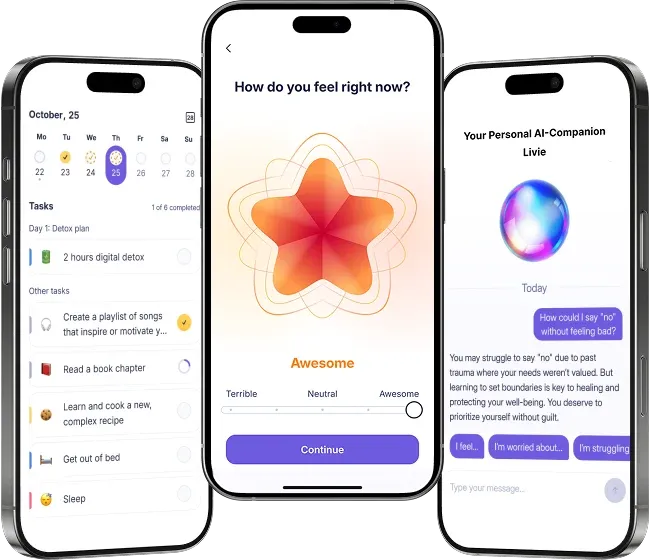Coping with Depression: Practical Strategies for Everyday Resilience

Introduction to Living with Depression
Recovery when you experience depression isn’t linear — we often believe that getting better means feeling better all the time. It’s not true, unfortunately. On some days, you might feel like your depression doesn’t bother you at all. But on others, it can worsen depression and symptoms of depression can creep into your mood and turn it grey. Don’t push yourself too much.
Coping with depression, living with it — these aren’t processes that happen in a flick of a finger. It’s a process. All roads take time and small, consistent steps to reach the end goal. Allow yourself to go at your own pace, whether it’s several months or more. Only you know what’s right for you, and your healing will progress naturally once you allow it. Learning to navigate depression means accepting your progress and setbacks at once.
Coping With Depression: Small Daily Habits Make a Difference
All great things start small. Even superheroes don’t save the world in one day after going through stressful life events. Here are a few self-care tips for when symptoms of depression get too much.
Setting realistic goals and routines
Severe depression tends to make things seem impossible. Hills of challenges turn into mountains. Setting achievable goals is a good way to counter the overwhelm during your treatment plan. These things have a significant role, no matter how tiny they seem.
Simplify routines. Some, when depressed, can’t force themselves to make their beds, brush their teeth, or do the dishes. If that’s the case for you, simplify these tasks. If brushing your teeth feels overwhelming, start with just using mouthwash, then build up to brushing. Those struggling with making a bed can try to pick a few items on it and tuck them in. The dishes? Buy paper plates and throw them away once you’ve eaten.
Anchor your tasks. Sometimes, it’s easier to add several tasks to the first one you do. Let’s say you link taking your pills with making breakfast. Or, after drinking coffee, open up a window and let the air in.
One goal a day. A lot of people feel overwhelmed and tired when depression becomes a part of their lives. Doing more can only increase stress and exacerbate depression symptoms. Commit to just one objective a day, something that is important but doesn’t require a thousand steps. For instance, you have to respond to several job-related emails, so assign this task to your Monday and slowly go through that stack.
Do the five-minute things. One of the primary sources of our daily stress is chores that take five minutes or less. There are so many of them that we stagger and extend our work. Make a list of five-minute tasks and cross a few off each day.
Practicing gratitude and journaling to manage depression symptoms
Even though depression puts a damper on the positive things we experience daily, we can adjust how we see them. It’s like readjusting the viewfinder that has gone off the rockers a little. Gratitude and journaling are two practices that, when done with knowledge of their purpose, can help you manage stress and boost your well-being.
Important: don’t look at gratitude as toxic or false positivity, where you force yourself to see things in a different light. This approach is never okay, and having different feelings is normal. What we mean is reminding ourselves that even one thing we encounter during the day brings us joy. Imagine those positive events that contribute to your well-being.
One of the simplest ways to practice journaling is by naming or writing down one positive thing that happened to you. We can suggest taking pictures, but it’ll overwhelm you. But maybe create an album on your phone with these tiny happy memories? Think about whether you’ll like it.
Journaling, on the other hand, isn’t just about the good stuff. You most benefit from everything: the good, the bad, and the ugly. Did you know that one of the main reasons why people don’t like rereading their journals is that they usually write only the bad things? Try “stream of consciousness” journaling, where you write without filtering thoughts. Then, if you want (or can), add something nice between those lines. Journaling is an excellent way for people to process events happening to them and express emotions affecting them. In some ways, those who decrease this mental clutter have free space in their minds.
Mindfulness and Relaxation Techniques for Mental Health
How to deal with depression symptoms and anxiety? To learn to live in the moment. People don’t live mindfully every moment of their lives — in truth, most of us are pretty detached. But adding a few mindful moments throughout the day can be helpful for those who tend to focus on the past or future too much.
Deep breathing and meditation
Deep breathing and meditation can help regulate emotions, reduce symptoms of stress and anxiety, and create moments of calm — even if just for a few seconds. They are known elements of treatment during therapy. Below are some mental health strategies you might try to manage the symptoms of stress and anxiety.
4-7-8 breathing. Inhale through your nose for 4 seconds, hold for 7 seconds, and exhale slowly through your mouth for 8 seconds. Repeat it for several minutes, and you will notice your heartbeat getting calmer and your mind slowly stopping to spin.
Box breathing. Breathe in for 4 counts, hold for 4, exhale for 4, and hold again for 4. It’s called “Box breathing” because individuals are usually encouraged to imagine tracing a square in their mind with each breath.
Meditation. The exercises above were more breathing than meditation, and this one’s specifically for exploring your mind. Find a comfortable spot where you can sit without being interrupted. No need for complete silence, but the background shouldn’t be distracting. Close your eyes (or soften your gaze) and take a slow, deep breath in through your nose. Repeat. And while you slowly start to shift into this breathing routine, study your thoughts. Don’t silence them. Instead, see them as clouds that pass by but don’t stay with you for long.
The role of nature and sensory grounding techniques
Being in nature is one of the most pleasing and inspiring ways to reconnect with one’s senses. Depression often makes us feel disconnected from the present moment, whereas the natural world can help us reconnect with our senses and the here and now. Research shows that spending time outside, in nature, and around greenery, whether in parks or forests, positively impacts mental health.
Dedicate ten minutes daily to going outside, even if it feels challenging. If you feel like the weather is bad or you can’t do it, open the window and let in the fresh air. If you have time, practice a 5-4-3-2-1 grounding method. While you’re in nature, name five things you can see, four you can touch, three you can hear, two you can smell, and one you can taste. If you feel emotionally numb or too overwhelmed, this practice will help you settle.
Sensory grounding can still work if you’re not in nature, but can spare a few minutes or even seconds. Aside from the practice above, you can try walking barefoot (not in the busy street, and be mindful of the glass) or dipping your hands in the water body — a lake or a river if you’ve gone on a longer hike. The same can work at home; for instance, you can splash cold water over your face or hold an ice cube to your skin. It’ll cause immediate relief during emotional distress by triggering the vagus nerve, which helps regulate mood.
The Role of Exercise and Nutrition
Our brains are complex things, but they are just a part of our body, and our physical health matters. Therefore, a balanced diet and exercise can influence how we deal and cope with mental illness, anxiety, and depressive symptoms. Exercise and nutrition are some of the most significant changes people with major depressive disorder and depression issues can implement in their lives to boost their mood.
How physical activity influences brain chemistry
You probably know already that moderate physical activity positively impacts brain chemistry. Interestingly, that’s not always the case with high activity levels, particularly because it can make your body and brain more exhausted. But we’re going for moderate and pleasurable when coping with depression, right? First of all, physical exercises facilitate the release of endorphins, which act as our brain’s mood elevators. Another thing it does is enhance your dopamine and serotonin regulation. A proper mix of exercises also reduces the release of cortisol. While we need cortisol, those with depression or symptoms of depression often have a higher cortisol secretion than those who do not report depressive symptoms or being depressed. Exercise often lowers stress levels, but only to an extent. Too much regular exercise can do more harm than good.
Here are just a few ideas for low-energy exercises that you can try with depression treatment:
- Walking or hiking
- Swimming
- Gentle stretching or yoga
- Simple bodyweight exercises (squats/wall pushups).
Foods that support mood and energy levels
Food nourishes our brain. Many daily habits for mental health we implement aim to return our bodies to the proper state through care. Those who don’t eat enough often report worse moods or even severe swings, so diet changes are often a part of the treatment plan. Here’s a short list of healthy foods to boost your mood and energy levels.
Omega-3 fatty acids. Found in salmon, walnuts, and flaxseeds, these support brain function and reduce inflammation linked to depression. You pack up some walnuts as a snack for your studies or work.
Complex carbs. Don’t skip eating these because they give your body a steady energy flow. Sweet potatoes, whole grains, and beans are all great sources to incorporate into a healthy diet for your lunch or dinner.
Foods rich in magnesium. Magnesium is known for its ability to contribute to relaxation and reduce sleep problems. Look for it in nuts and bananas — great snacks as well.
Water. We know that’s not food per se, but a lot of people suffering from depression forget to drink, and hydration does help in reducing brain fog and fatigue.
We know that if you’re tired, you don’t want to make an entirely new meal. Instead, go for simple stuff: make a salad, combine it with a sandwich, or even pair up your chips with those berries you like.
Social Support and Connection
Humans are inherently social. It’s not surprising that, in ancient times, the worst punishment someone could receive was isolation. We crave human company even when we think we don’t. As studies show, strong social systems can even prevent depression in general population. That’s why social support plays such a crucial role in depression self-care.
Building a reliable support system
A support system consists of people who can be there for you when you’re feeling down. These individuals bring you joy and remind you that even the worst day ends and the other one might be at least a little better.
Go for quality over quantity: you don’t need twenty people in your emotional support network if you can’t trust or rely on half of them. Having three close friends or family members who will have your back is better. Look for those who can listen and spare judgment.
Remember that you don’t have to start a talk for an entire day, and having a huge commitment is not obligatory when you just need company. You can text your friend, “Hey, send me some positive memes,” or “Just checking in. Hi?” These are pretty low-effort but will break the feeling of isolation.
What do you do if you’ve got some toxic or unsupportive people? Set boundaries. We know it can get a bit tough, especially if you’re a recovering people-pleaser, but those who hurt your mental wellness can suck out that precious energy you have. Protect your energy by limiting interactions with those who dismiss or invalidate your feelings.
Finding community through hobbies and activities
Sometimes, we all need to be around others without discussing our feelings. Depression affects our socialization, so try out hobbies and activities.
Low-effort socializing. Developing an entirely new routine to go to daily meetups can be too much. Look for activities where you don’t have to talk all the time and where you don’t have to meet every week:
- Book club
- One-time art or culinary classes
- Visiting a pet cafe or an animal shelter.
Online communities. We know the Internet has received a bad reputation, but lots of people find personal connections through it. Plus, there are many groups based on interests where you can connect, chat, and share projects based on what hobby you’re focused on. For example, Reddit and Facebook have some of the largest lists of hobby communities, ranging from biking to creating miniatures.
Volunteering. Volunteering is an outstanding way to connect with other people while also doing something gentle and meaningful. Spending time on noble causes gives us a sense of purpose and motivates us to try something new. There are simpler, low-energy commitments, such as writing letters to vulnerable populations or assisting local libraries.
When to Seek Help from a Mental Health Professional
Sometimes, you can’t do it all on your own, and it’s alright. You might need the assistance of a qualified mental health professional. Remember that you don’t have to do this alone; when you seek professional support from a mental health provider, it is a sign of healing.
Recognizing when self-help strategies aren’t enough
Signs that the existing self-help strategies may not be enough include:
Inability to perform basic tasks. If you struggle to get out of bed, shower, or complete school/work tasks, it might be a sign you need professional help.
Severe isolation. This means avoiding people even when help is available or staying alone in situations when it becomes overly prevalent - a potential sign you've got major depression.
Physical symptoms. Some people suffer from symptoms, such as stomachaches, headaches, or significant shifts in appetite, weight loss or weight gain, or sleep, even after all lifestyle adjustments. These symptoms are often unexplainable and don’t have roots in underlying causes.
Persistent sadness. If your feelings of despair last for weeks and don’t seem to change, it can be a sign that your current resources don’t sustain you without help from someone else.
Suicidal thoughts. Suicidal thoughts should never be taken lightly. If you have thoughts about hurting yourself, professional help is a necessity. Seek out immediate support — it might feel like you’re alone, but you just have to find the right people to connect with.
How to choose a qualified mental health professional
Finding the right professional for your clinical depression might seem overwhelming, but breaking it down into smaller steps can make the process more manageable. And it can be the decisive factor for your mental health.
Don’t know what the difference is between each mental health provider? Therapists — these include psychologists or counselors, as a rule — offer talk therapy, such as cognitive-behavioral or dialectical therapy, and work with clients to challenge their harmful ideas or help them develop new coping strategies. Psychiatrists, on the other hand, can prescribe medication treatment and adjust it based on the person’s needs and state. It doesn’t mean you will need medical treatment, but if you do, there’s nothing wrong with that. The first step is to reach out for assistance and go from there.
If you’ve never searched for professional help, start online. Look for the websites in your native language, especially the local ones, if you want to look for offline consultations later. Search through the university counseling centers and nonprofits offering free or low-cost therapy if you are limited in resources.
Choosing the right specialist for your goals can be troubling if you don’t know what you like, but remember that the main criterion is a sense of trust. Think about whether you’d feel more comfortable working with a man or a woman, and think about their age and therapy approach. Although finding help for depression is essential, people searching for the right fit shouldn’t choose someone they don’t like. As you look at the profiles or read therapists’ descriptions online, you will better understand what specialist you need.
Conclusion: Building a Sustainable Self-Care Routine
We want to end this article the same way we started it: by reminding you that healing is more about consistency than immediate results. Every step you take toward it will have its mark, but you have to be patient and kind. Just like we grow out of clothes that no longer fit us, we can grow out of other things, but it’s not immediate.
As you go, remember that you have to be compassionate toward yourself. You are an immensely brave and resourceful person, and you deserve to move at the pace you need. Like a seedling daring to finally set its roots, just stretch those tiny branches and prepare to grow.
References
Golshani, S., Najafpour, A., Hashemian, S. S., Goudarzi, N., Shahmari, F., Golshani, S., Babaei, M., Firoozabadi, K., Dürsteler, K. M., Brühl, A. B., Shakeri, J., Brand, S., & Sadeghi-Bahmani, D. (2021). When much is too much—compared to light exercisers, heavy exercisers report more mental health issues and stress, but less sleep complaints. Healthcare, 9(10), 1289. https://doi.org/10.3390/healthcare9101289
Jenkinson, C. E., Dickens, A. P., Jones, K., Thompson-Coon, J., Taylor, R. S., Rogers, M., Bambra, C. L., Lang, I., & Richards, S. H. (2013). Is volunteering a public health intervention? A systematic review and meta-analysis of the Health and survival of volunteers. BMC Public Health, 13(1). https://doi.org/10.1186/1471-2458-13-773

